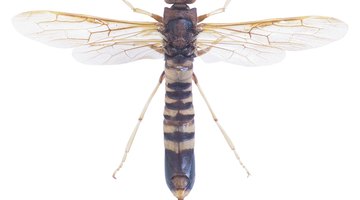Types of Mud Wasps
Table of Contents
There are numerous types of mud wasps across the world. Most are solitary wasps but a few live in small colonies. Some mud dwelling wasps simply dig holes into the ground to dwell, other build mud hives and a few build elaborate, intricate mud houses.

Most wasps who dwell in mud keep to themselves and are rarely aggressive. They can all sting repeatedly if cornered or provoked but they do not normally look for confrontations with humans or animals.
Potter Wasp
The potter wasp (Eumenes fraternus) commonly constructs small nests made of mud but will also move into abandoned nests that once belonged to other wasps. Each nest the potter wasp constructs is made from simple mud and water. Nests can contain one or more chambers. The wasp will fill the chamber or chambers with prey items such as beetle carcasses, spiders or caterpillars. The potter wasp will then lay a larvae which will hatch and feed on the food collection in the chamber. Adult potter wasps feed only on plant nectar. Adult potter wasps are glossy black with a few simple white stripes.
Cicada Killer Wasp
The cicada killer wasp (Sphecius speciosus) is quite large and will often measure 2 inches in length. The wasps live in large burrows in dirt that are surrounded by the mound of dirt that the wasp removed from the ground to make the cavities. They try to dig their homes into dirt located in the full sun. The cicada killer will collect numerous insects to stuff into their dirt house. Once the chamber is filled with food the cicada wasp will lay eggs. When the larvae emerges they can easily feed on the insect body collection. The adult cicada killer wasp lives solely on nectar from flowers.
Organ-Pipe Mud Dauber
The organ-pipe mud dauber (Trypoxylon politum) female builds elaborate long mud nests that are suspended from buildings, bridges or other structures. The tubes of the nest are often built in clusters that resemble the pipes of an organ. Each one of the chambers of her mud nest she fills with spider carcasses to feed her young. Male mud daubers remain in the nest to protect the nest from enemies and other mud daubers while the female constructs more tubes and forages to return with food.
Black and Yellow Mud Dauber
The black and yellow mud dauber (Sceliphron caementarium) constructs a rounded mud nest. Each nest can contain one to several chambers. Females and males gather large balls of mud with their front legs and then return to the nest to construct. The cavities are filled with spider bodies to feed the emerging wasp larvae.
Blue Mud Dauber
The blue mud dauber (Chalybion californicum) does not build their own mud nests but takes over the nests of the black and yellow mud dauber. Once the blue mud dauber locates a nest to take over they quickly fill the nest with carcasses of black widow spiders only. These will feed the blue mud daubers larvae upon hatching.
References
Resources
Writer Bio
Based in Oregon, Kimberly Sharpe has been a writer since 2006. She writes for numerous online publications. Her writing has a strong focus on home improvement, gardening, parenting, pets and travel. She has traveled extensively to such places as India and Sri Lanka to widen and enhance her writing and knowledge base.
Photo Credits
- Hemera Technologies/PhotoObjects.net/Getty Images
- Hemera Technologies/PhotoObjects.net/Getty Images
More Articles



